Globalisation's Impact on Fine Dining and Cultural Identity
VerifiedAdded on 2020/10/05
|10
|3079
|456
Essay
AI Summary
This essay delves into the multifaceted impact of globalisation on the culinary world, specifically focusing on fine dining and cultural identity. Section A critically discusses globalisation's influence on the food industry, highlighting the rise of international businesses, the use of technology, and the expansion into new markets. It explores both the benefits and challenges of globalisation, including homogenisation and heterogenisation in food consumption and cultural identity. Section B concentrates on the development of fine dining, examining the contributions of culinary pioneers like Marie Antonin Carême, Georges Auguste Escoffier, and Michel Roux Jr. The essay analyzes their innovations and how they shaped the evolution of fine dining practices and the broader culinary landscape. The paper emphasizes the interplay between global trends and local cultural nuances within the food and beverage sector, providing a comprehensive overview of the subject.
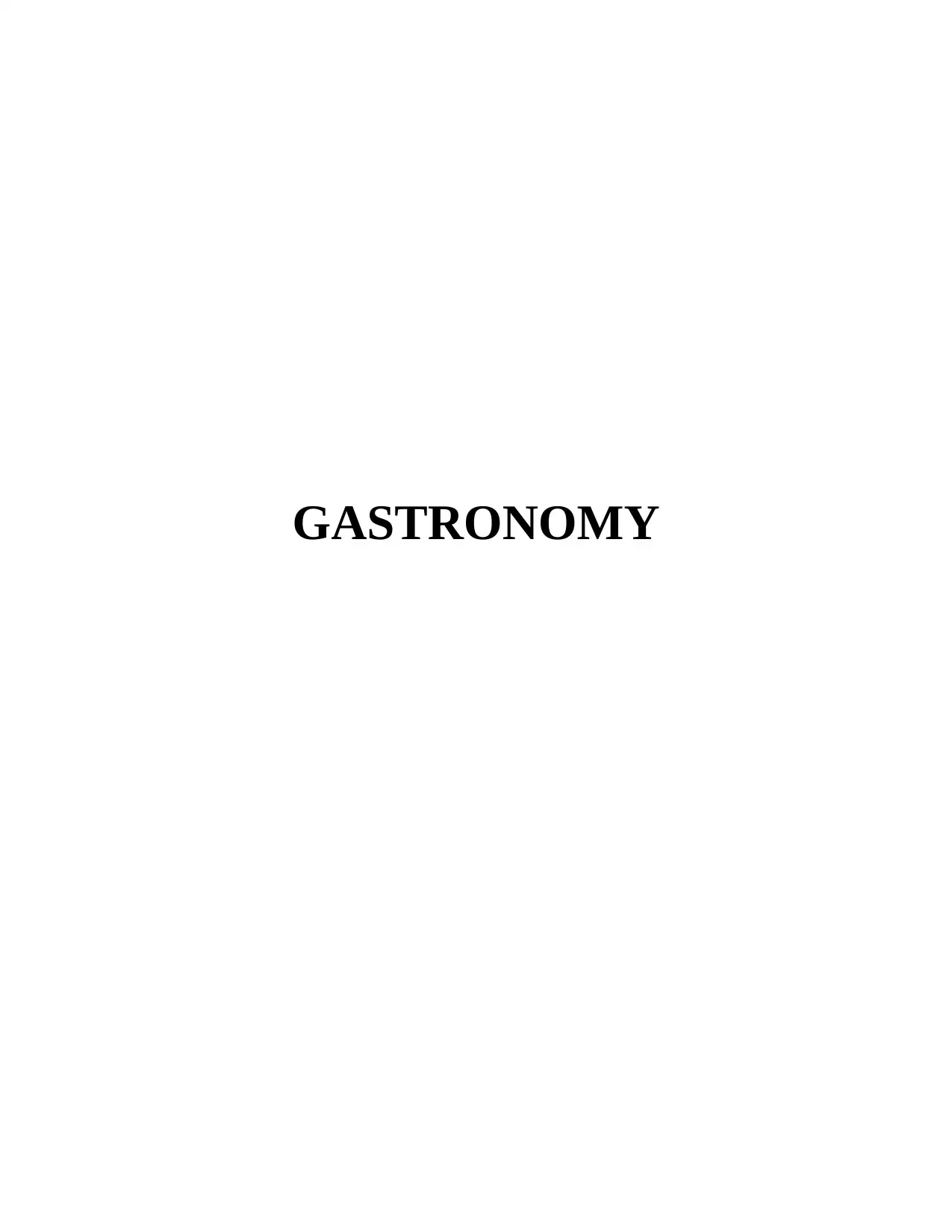
GASTRONOMY
Paraphrase This Document
Need a fresh take? Get an instant paraphrase of this document with our AI Paraphraser
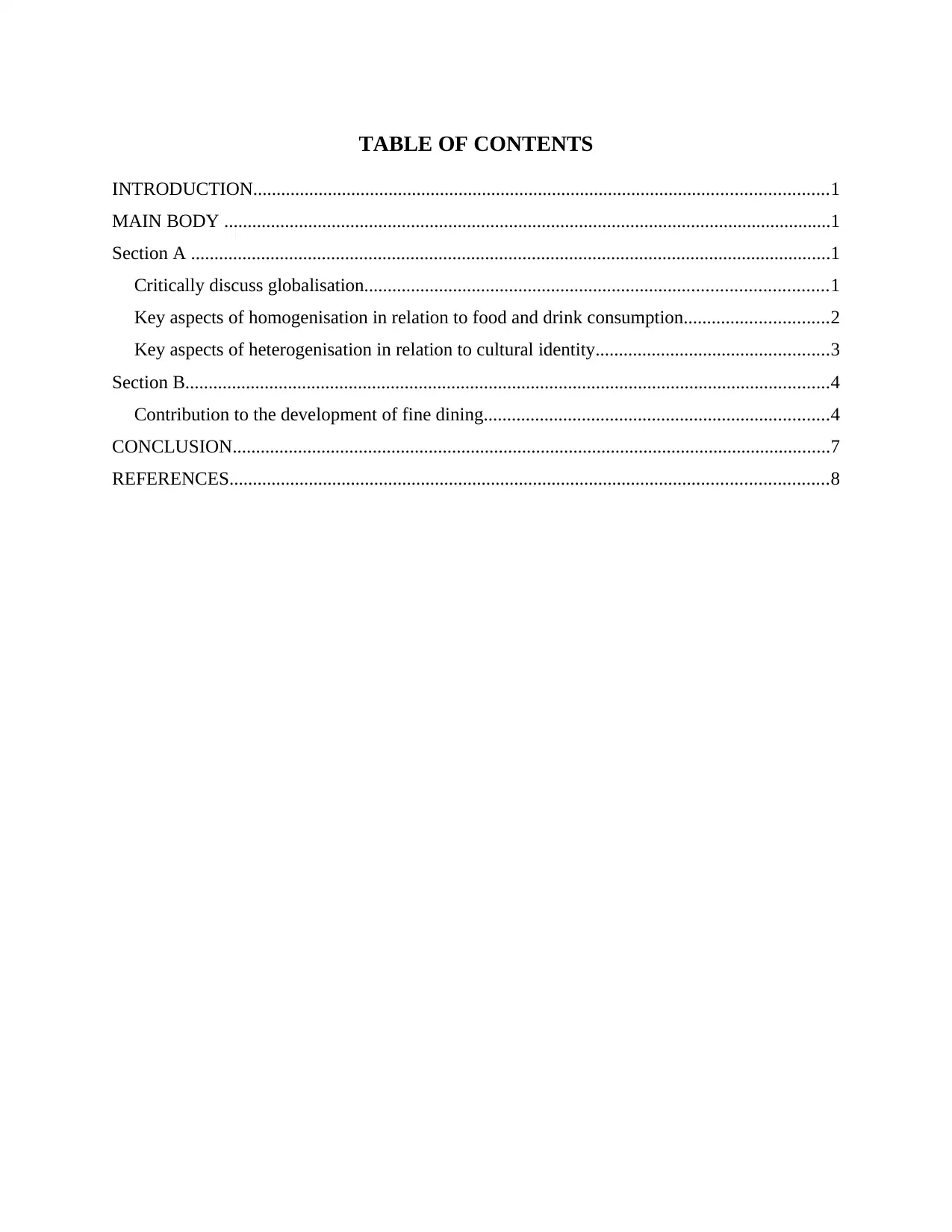
TABLE OF CONTENTS
INTRODUCTION...........................................................................................................................1
MAIN BODY ..................................................................................................................................1
Section A .........................................................................................................................................1
Critically discuss globalisation...................................................................................................1
Key aspects of homogenisation in relation to food and drink consumption...............................2
Key aspects of heterogenisation in relation to cultural identity..................................................3
Section B..........................................................................................................................................4
Contribution to the development of fine dining..........................................................................4
CONCLUSION................................................................................................................................7
REFERENCES................................................................................................................................8
INTRODUCTION...........................................................................................................................1
MAIN BODY ..................................................................................................................................1
Section A .........................................................................................................................................1
Critically discuss globalisation...................................................................................................1
Key aspects of homogenisation in relation to food and drink consumption...............................2
Key aspects of heterogenisation in relation to cultural identity..................................................3
Section B..........................................................................................................................................4
Contribution to the development of fine dining..........................................................................4
CONCLUSION................................................................................................................................7
REFERENCES................................................................................................................................8
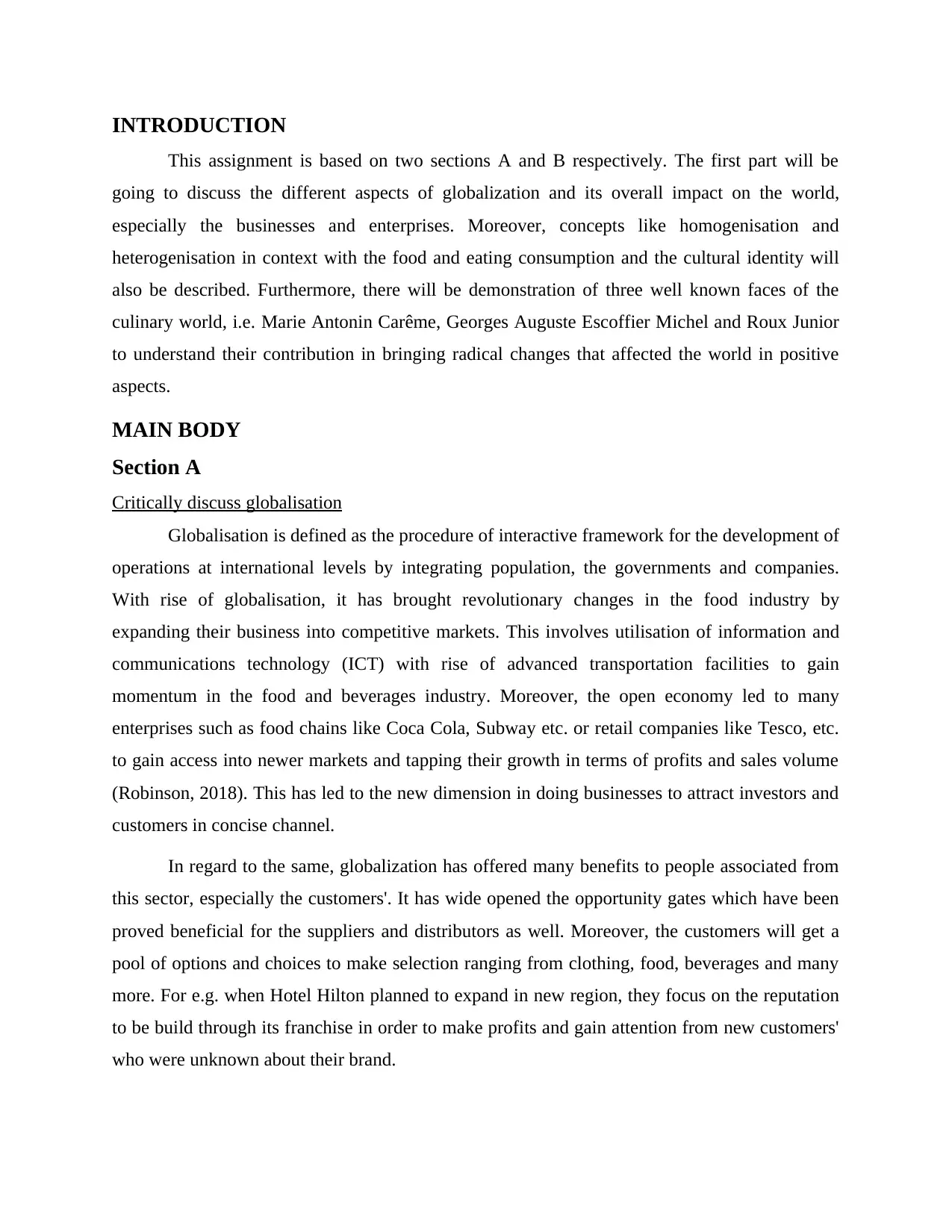
INTRODUCTION
This assignment is based on two sections A and B respectively. The first part will be
going to discuss the different aspects of globalization and its overall impact on the world,
especially the businesses and enterprises. Moreover, concepts like homogenisation and
heterogenisation in context with the food and eating consumption and the cultural identity will
also be described. Furthermore, there will be demonstration of three well known faces of the
culinary world, i.e. Marie Antonin Carême, Georges Auguste Escoffier Michel and Roux Junior
to understand their contribution in bringing radical changes that affected the world in positive
aspects.
MAIN BODY
Section A
Critically discuss globalisation
Globalisation is defined as the procedure of interactive framework for the development of
operations at international levels by integrating population, the governments and companies.
With rise of globalisation, it has brought revolutionary changes in the food industry by
expanding their business into competitive markets. This involves utilisation of information and
communications technology (ICT) with rise of advanced transportation facilities to gain
momentum in the food and beverages industry. Moreover, the open economy led to many
enterprises such as food chains like Coca Cola, Subway etc. or retail companies like Tesco, etc.
to gain access into newer markets and tapping their growth in terms of profits and sales volume
(Robinson, 2018). This has led to the new dimension in doing businesses to attract investors and
customers in concise channel.
In regard to the same, globalization has offered many benefits to people associated from
this sector, especially the customers'. It has wide opened the opportunity gates which have been
proved beneficial for the suppliers and distributors as well. Moreover, the customers will get a
pool of options and choices to make selection ranging from clothing, food, beverages and many
more. For e.g. when Hotel Hilton planned to expand in new region, they focus on the reputation
to be build through its franchise in order to make profits and gain attention from new customers'
who were unknown about their brand.
This assignment is based on two sections A and B respectively. The first part will be
going to discuss the different aspects of globalization and its overall impact on the world,
especially the businesses and enterprises. Moreover, concepts like homogenisation and
heterogenisation in context with the food and eating consumption and the cultural identity will
also be described. Furthermore, there will be demonstration of three well known faces of the
culinary world, i.e. Marie Antonin Carême, Georges Auguste Escoffier Michel and Roux Junior
to understand their contribution in bringing radical changes that affected the world in positive
aspects.
MAIN BODY
Section A
Critically discuss globalisation
Globalisation is defined as the procedure of interactive framework for the development of
operations at international levels by integrating population, the governments and companies.
With rise of globalisation, it has brought revolutionary changes in the food industry by
expanding their business into competitive markets. This involves utilisation of information and
communications technology (ICT) with rise of advanced transportation facilities to gain
momentum in the food and beverages industry. Moreover, the open economy led to many
enterprises such as food chains like Coca Cola, Subway etc. or retail companies like Tesco, etc.
to gain access into newer markets and tapping their growth in terms of profits and sales volume
(Robinson, 2018). This has led to the new dimension in doing businesses to attract investors and
customers in concise channel.
In regard to the same, globalization has offered many benefits to people associated from
this sector, especially the customers'. It has wide opened the opportunity gates which have been
proved beneficial for the suppliers and distributors as well. Moreover, the customers will get a
pool of options and choices to make selection ranging from clothing, food, beverages and many
more. For e.g. when Hotel Hilton planned to expand in new region, they focus on the reputation
to be build through its franchise in order to make profits and gain attention from new customers'
who were unknown about their brand.
⊘ This is a preview!⊘
Do you want full access?
Subscribe today to unlock all pages.

Trusted by 1+ million students worldwide
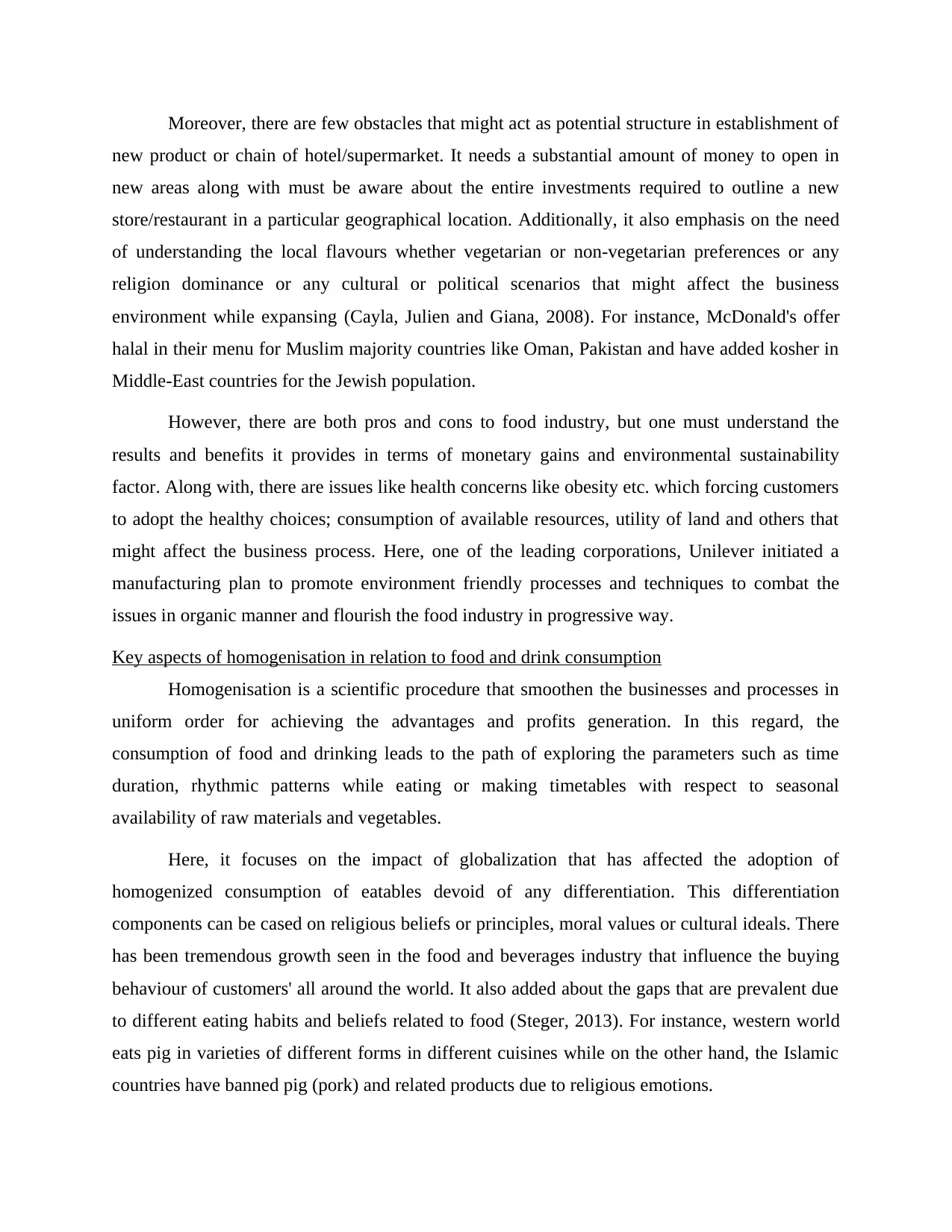
Moreover, there are few obstacles that might act as potential structure in establishment of
new product or chain of hotel/supermarket. It needs a substantial amount of money to open in
new areas along with must be aware about the entire investments required to outline a new
store/restaurant in a particular geographical location. Additionally, it also emphasis on the need
of understanding the local flavours whether vegetarian or non-vegetarian preferences or any
religion dominance or any cultural or political scenarios that might affect the business
environment while expansing (Cayla, Julien and Giana, 2008). For instance, McDonald's offer
halal in their menu for Muslim majority countries like Oman, Pakistan and have added kosher in
Middle-East countries for the Jewish population.
However, there are both pros and cons to food industry, but one must understand the
results and benefits it provides in terms of monetary gains and environmental sustainability
factor. Along with, there are issues like health concerns like obesity etc. which forcing customers
to adopt the healthy choices; consumption of available resources, utility of land and others that
might affect the business process. Here, one of the leading corporations, Unilever initiated a
manufacturing plan to promote environment friendly processes and techniques to combat the
issues in organic manner and flourish the food industry in progressive way.
Key aspects of homogenisation in relation to food and drink consumption
Homogenisation is a scientific procedure that smoothen the businesses and processes in
uniform order for achieving the advantages and profits generation. In this regard, the
consumption of food and drinking leads to the path of exploring the parameters such as time
duration, rhythmic patterns while eating or making timetables with respect to seasonal
availability of raw materials and vegetables.
Here, it focuses on the impact of globalization that has affected the adoption of
homogenized consumption of eatables devoid of any differentiation. This differentiation
components can be cased on religious beliefs or principles, moral values or cultural ideals. There
has been tremendous growth seen in the food and beverages industry that influence the buying
behaviour of customers' all around the world. It also added about the gaps that are prevalent due
to different eating habits and beliefs related to food (Steger, 2013). For instance, western world
eats pig in varieties of different forms in different cuisines while on the other hand, the Islamic
countries have banned pig (pork) and related products due to religious emotions.
new product or chain of hotel/supermarket. It needs a substantial amount of money to open in
new areas along with must be aware about the entire investments required to outline a new
store/restaurant in a particular geographical location. Additionally, it also emphasis on the need
of understanding the local flavours whether vegetarian or non-vegetarian preferences or any
religion dominance or any cultural or political scenarios that might affect the business
environment while expansing (Cayla, Julien and Giana, 2008). For instance, McDonald's offer
halal in their menu for Muslim majority countries like Oman, Pakistan and have added kosher in
Middle-East countries for the Jewish population.
However, there are both pros and cons to food industry, but one must understand the
results and benefits it provides in terms of monetary gains and environmental sustainability
factor. Along with, there are issues like health concerns like obesity etc. which forcing customers
to adopt the healthy choices; consumption of available resources, utility of land and others that
might affect the business process. Here, one of the leading corporations, Unilever initiated a
manufacturing plan to promote environment friendly processes and techniques to combat the
issues in organic manner and flourish the food industry in progressive way.
Key aspects of homogenisation in relation to food and drink consumption
Homogenisation is a scientific procedure that smoothen the businesses and processes in
uniform order for achieving the advantages and profits generation. In this regard, the
consumption of food and drinking leads to the path of exploring the parameters such as time
duration, rhythmic patterns while eating or making timetables with respect to seasonal
availability of raw materials and vegetables.
Here, it focuses on the impact of globalization that has affected the adoption of
homogenized consumption of eatables devoid of any differentiation. This differentiation
components can be cased on religious beliefs or principles, moral values or cultural ideals. There
has been tremendous growth seen in the food and beverages industry that influence the buying
behaviour of customers' all around the world. It also added about the gaps that are prevalent due
to different eating habits and beliefs related to food (Steger, 2013). For instance, western world
eats pig in varieties of different forms in different cuisines while on the other hand, the Islamic
countries have banned pig (pork) and related products due to religious emotions.
Paraphrase This Document
Need a fresh take? Get an instant paraphrase of this document with our AI Paraphraser
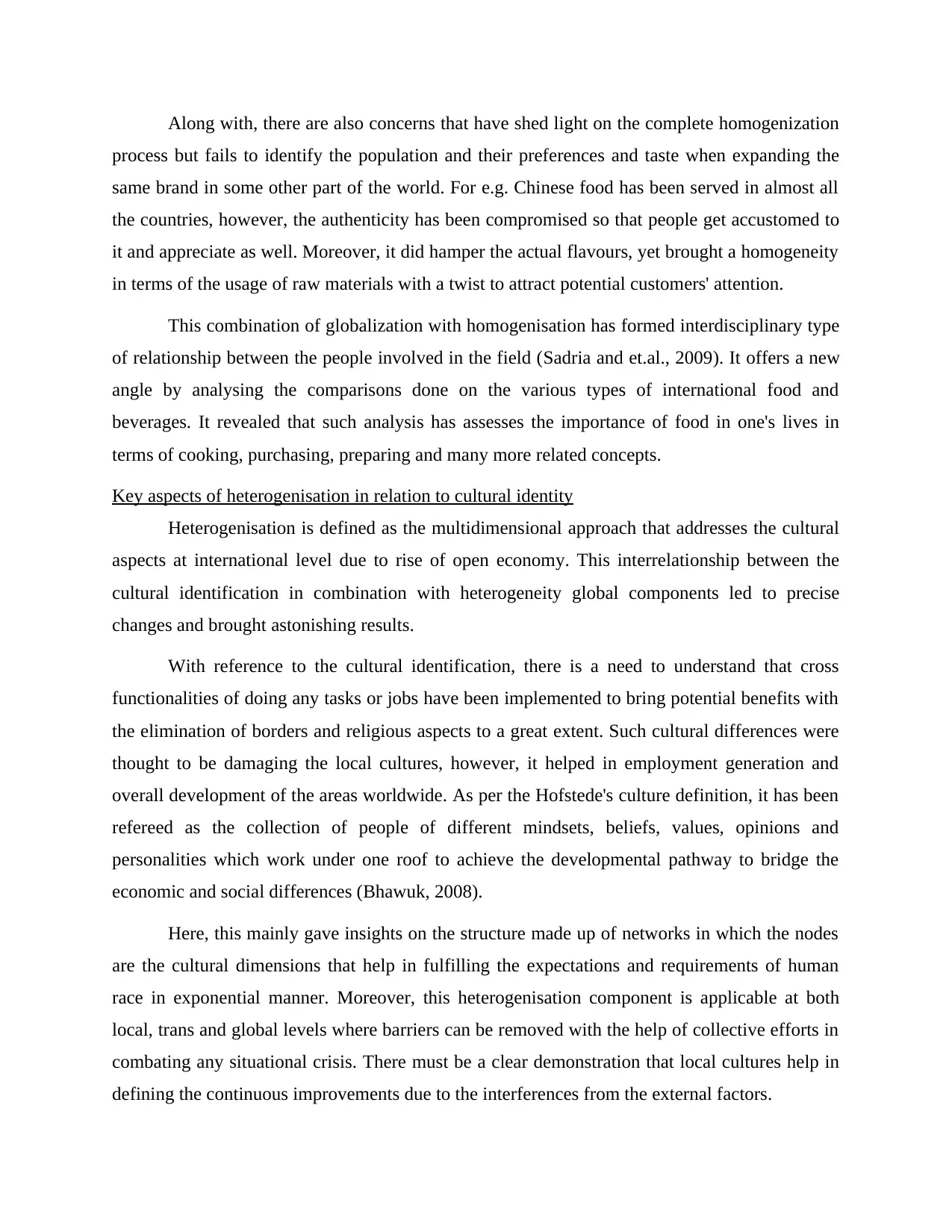
Along with, there are also concerns that have shed light on the complete homogenization
process but fails to identify the population and their preferences and taste when expanding the
same brand in some other part of the world. For e.g. Chinese food has been served in almost all
the countries, however, the authenticity has been compromised so that people get accustomed to
it and appreciate as well. Moreover, it did hamper the actual flavours, yet brought a homogeneity
in terms of the usage of raw materials with a twist to attract potential customers' attention.
This combination of globalization with homogenisation has formed interdisciplinary type
of relationship between the people involved in the field (Sadria and et.al., 2009). It offers a new
angle by analysing the comparisons done on the various types of international food and
beverages. It revealed that such analysis has assesses the importance of food in one's lives in
terms of cooking, purchasing, preparing and many more related concepts.
Key aspects of heterogenisation in relation to cultural identity
Heterogenisation is defined as the multidimensional approach that addresses the cultural
aspects at international level due to rise of open economy. This interrelationship between the
cultural identification in combination with heterogeneity global components led to precise
changes and brought astonishing results.
With reference to the cultural identification, there is a need to understand that cross
functionalities of doing any tasks or jobs have been implemented to bring potential benefits with
the elimination of borders and religious aspects to a great extent. Such cultural differences were
thought to be damaging the local cultures, however, it helped in employment generation and
overall development of the areas worldwide. As per the Hofstede's culture definition, it has been
refereed as the collection of people of different mindsets, beliefs, values, opinions and
personalities which work under one roof to achieve the developmental pathway to bridge the
economic and social differences (Bhawuk, 2008).
Here, this mainly gave insights on the structure made up of networks in which the nodes
are the cultural dimensions that help in fulfilling the expectations and requirements of human
race in exponential manner. Moreover, this heterogenisation component is applicable at both
local, trans and global levels where barriers can be removed with the help of collective efforts in
combating any situational crisis. There must be a clear demonstration that local cultures help in
defining the continuous improvements due to the interferences from the external factors.
process but fails to identify the population and their preferences and taste when expanding the
same brand in some other part of the world. For e.g. Chinese food has been served in almost all
the countries, however, the authenticity has been compromised so that people get accustomed to
it and appreciate as well. Moreover, it did hamper the actual flavours, yet brought a homogeneity
in terms of the usage of raw materials with a twist to attract potential customers' attention.
This combination of globalization with homogenisation has formed interdisciplinary type
of relationship between the people involved in the field (Sadria and et.al., 2009). It offers a new
angle by analysing the comparisons done on the various types of international food and
beverages. It revealed that such analysis has assesses the importance of food in one's lives in
terms of cooking, purchasing, preparing and many more related concepts.
Key aspects of heterogenisation in relation to cultural identity
Heterogenisation is defined as the multidimensional approach that addresses the cultural
aspects at international level due to rise of open economy. This interrelationship between the
cultural identification in combination with heterogeneity global components led to precise
changes and brought astonishing results.
With reference to the cultural identification, there is a need to understand that cross
functionalities of doing any tasks or jobs have been implemented to bring potential benefits with
the elimination of borders and religious aspects to a great extent. Such cultural differences were
thought to be damaging the local cultures, however, it helped in employment generation and
overall development of the areas worldwide. As per the Hofstede's culture definition, it has been
refereed as the collection of people of different mindsets, beliefs, values, opinions and
personalities which work under one roof to achieve the developmental pathway to bridge the
economic and social differences (Bhawuk, 2008).
Here, this mainly gave insights on the structure made up of networks in which the nodes
are the cultural dimensions that help in fulfilling the expectations and requirements of human
race in exponential manner. Moreover, this heterogenisation component is applicable at both
local, trans and global levels where barriers can be removed with the help of collective efforts in
combating any situational crisis. There must be a clear demonstration that local cultures help in
defining the continuous improvements due to the interferences from the external factors.
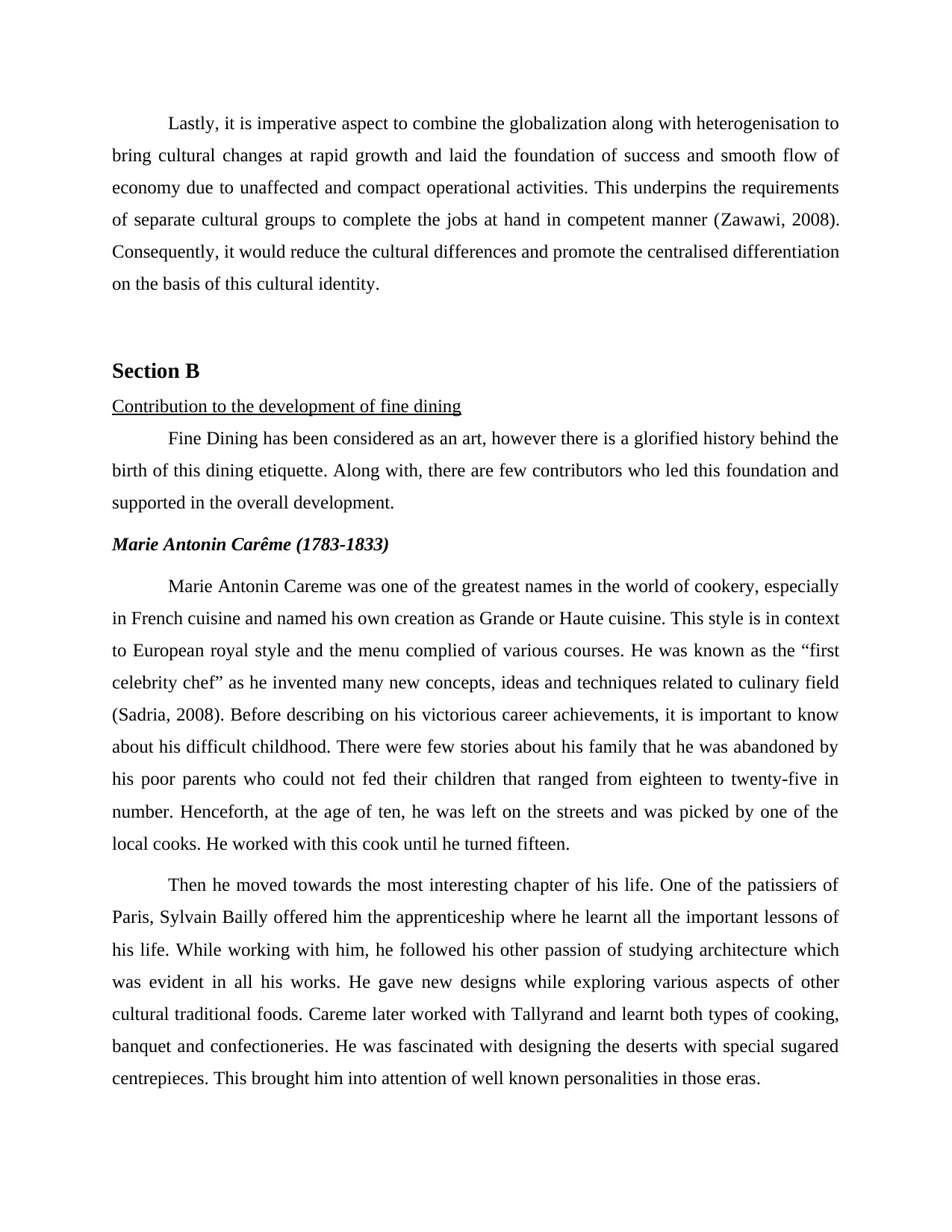
Lastly, it is imperative aspect to combine the globalization along with heterogenisation to
bring cultural changes at rapid growth and laid the foundation of success and smooth flow of
economy due to unaffected and compact operational activities. This underpins the requirements
of separate cultural groups to complete the jobs at hand in competent manner (Zawawi, 2008).
Consequently, it would reduce the cultural differences and promote the centralised differentiation
on the basis of this cultural identity.
Section B
Contribution to the development of fine dining
Fine Dining has been considered as an art, however there is a glorified history behind the
birth of this dining etiquette. Along with, there are few contributors who led this foundation and
supported in the overall development.
Marie Antonin Carême (1783-1833)
Marie Antonin Careme was one of the greatest names in the world of cookery, especially
in French cuisine and named his own creation as Grande or Haute cuisine. This style is in context
to European royal style and the menu complied of various courses. He was known as the “first
celebrity chef” as he invented many new concepts, ideas and techniques related to culinary field
(Sadria, 2008). Before describing on his victorious career achievements, it is important to know
about his difficult childhood. There were few stories about his family that he was abandoned by
his poor parents who could not fed their children that ranged from eighteen to twenty-five in
number. Henceforth, at the age of ten, he was left on the streets and was picked by one of the
local cooks. He worked with this cook until he turned fifteen.
Then he moved towards the most interesting chapter of his life. One of the patissiers of
Paris, Sylvain Bailly offered him the apprenticeship where he learnt all the important lessons of
his life. While working with him, he followed his other passion of studying architecture which
was evident in all his works. He gave new designs while exploring various aspects of other
cultural traditional foods. Careme later worked with Tallyrand and learnt both types of cooking,
banquet and confectioneries. He was fascinated with designing the deserts with special sugared
centrepieces. This brought him into attention of well known personalities in those eras.
bring cultural changes at rapid growth and laid the foundation of success and smooth flow of
economy due to unaffected and compact operational activities. This underpins the requirements
of separate cultural groups to complete the jobs at hand in competent manner (Zawawi, 2008).
Consequently, it would reduce the cultural differences and promote the centralised differentiation
on the basis of this cultural identity.
Section B
Contribution to the development of fine dining
Fine Dining has been considered as an art, however there is a glorified history behind the
birth of this dining etiquette. Along with, there are few contributors who led this foundation and
supported in the overall development.
Marie Antonin Carême (1783-1833)
Marie Antonin Careme was one of the greatest names in the world of cookery, especially
in French cuisine and named his own creation as Grande or Haute cuisine. This style is in context
to European royal style and the menu complied of various courses. He was known as the “first
celebrity chef” as he invented many new concepts, ideas and techniques related to culinary field
(Sadria, 2008). Before describing on his victorious career achievements, it is important to know
about his difficult childhood. There were few stories about his family that he was abandoned by
his poor parents who could not fed their children that ranged from eighteen to twenty-five in
number. Henceforth, at the age of ten, he was left on the streets and was picked by one of the
local cooks. He worked with this cook until he turned fifteen.
Then he moved towards the most interesting chapter of his life. One of the patissiers of
Paris, Sylvain Bailly offered him the apprenticeship where he learnt all the important lessons of
his life. While working with him, he followed his other passion of studying architecture which
was evident in all his works. He gave new designs while exploring various aspects of other
cultural traditional foods. Careme later worked with Tallyrand and learnt both types of cooking,
banquet and confectioneries. He was fascinated with designing the deserts with special sugared
centrepieces. This brought him into attention of well known personalities in those eras.
⊘ This is a preview!⊘
Do you want full access?
Subscribe today to unlock all pages.

Trusted by 1+ million students worldwide
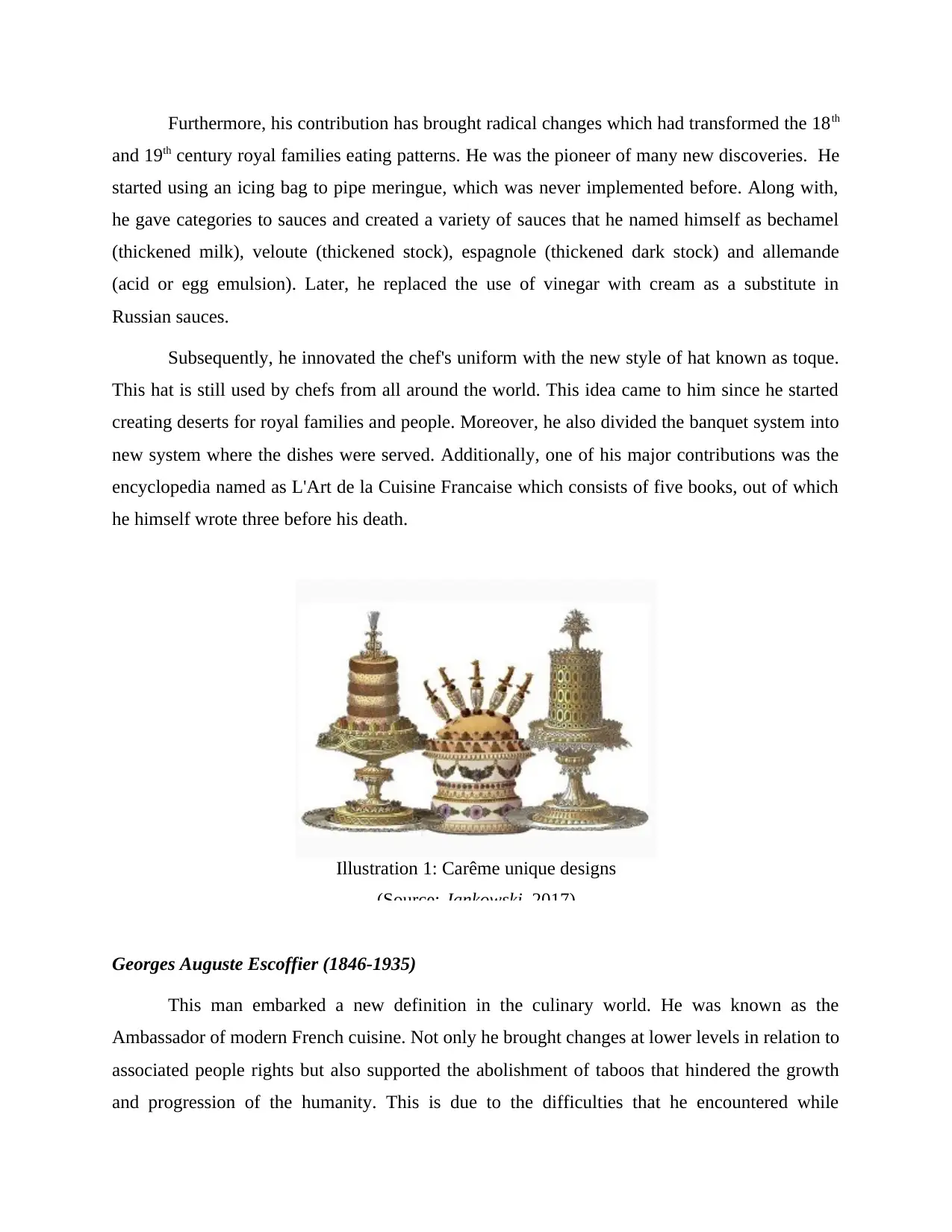
Furthermore, his contribution has brought radical changes which had transformed the 18th
and 19th century royal families eating patterns. He was the pioneer of many new discoveries. He
started using an icing bag to pipe meringue, which was never implemented before. Along with,
he gave categories to sauces and created a variety of sauces that he named himself as bechamel
(thickened milk), veloute (thickened stock), espagnole (thickened dark stock) and allemande
(acid or egg emulsion). Later, he replaced the use of vinegar with cream as a substitute in
Russian sauces.
Subsequently, he innovated the chef's uniform with the new style of hat known as toque.
This hat is still used by chefs from all around the world. This idea came to him since he started
creating deserts for royal families and people. Moreover, he also divided the banquet system into
new system where the dishes were served. Additionally, one of his major contributions was the
encyclopedia named as L'Art de la Cuisine Francaise which consists of five books, out of which
he himself wrote three before his death.
Georges Auguste Escoffier (1846-1935)
This man embarked a new definition in the culinary world. He was known as the
Ambassador of modern French cuisine. Not only he brought changes at lower levels in relation to
associated people rights but also supported the abolishment of taboos that hindered the growth
and progression of the humanity. This is due to the difficulties that he encountered while
Illustration 1: Carême unique designs
(Source: Jankowski, 2017)
and 19th century royal families eating patterns. He was the pioneer of many new discoveries. He
started using an icing bag to pipe meringue, which was never implemented before. Along with,
he gave categories to sauces and created a variety of sauces that he named himself as bechamel
(thickened milk), veloute (thickened stock), espagnole (thickened dark stock) and allemande
(acid or egg emulsion). Later, he replaced the use of vinegar with cream as a substitute in
Russian sauces.
Subsequently, he innovated the chef's uniform with the new style of hat known as toque.
This hat is still used by chefs from all around the world. This idea came to him since he started
creating deserts for royal families and people. Moreover, he also divided the banquet system into
new system where the dishes were served. Additionally, one of his major contributions was the
encyclopedia named as L'Art de la Cuisine Francaise which consists of five books, out of which
he himself wrote three before his death.
Georges Auguste Escoffier (1846-1935)
This man embarked a new definition in the culinary world. He was known as the
Ambassador of modern French cuisine. Not only he brought changes at lower levels in relation to
associated people rights but also supported the abolishment of taboos that hindered the growth
and progression of the humanity. This is due to the difficulties that he encountered while
Illustration 1: Carême unique designs
(Source: Jankowski, 2017)
Paraphrase This Document
Need a fresh take? Get an instant paraphrase of this document with our AI Paraphraser
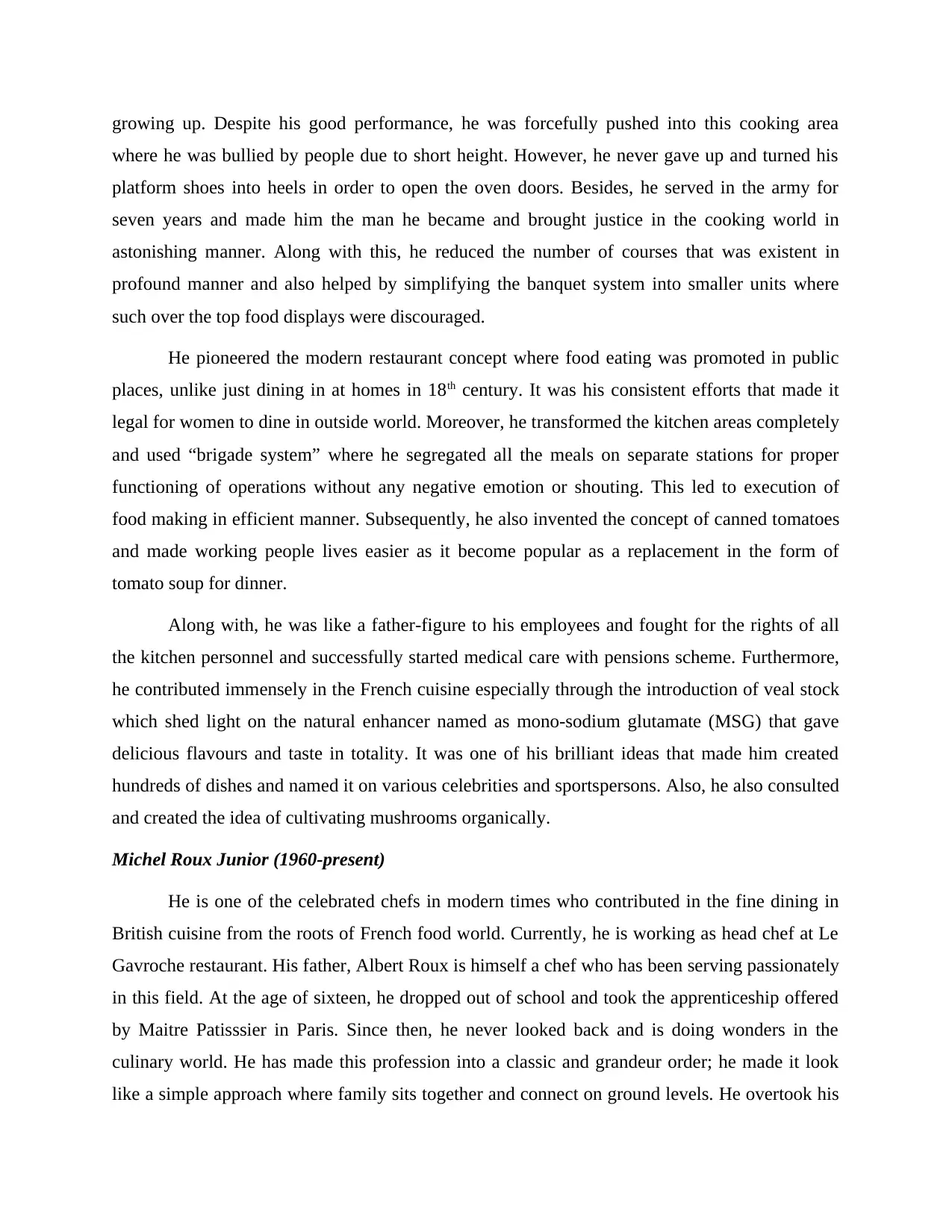
growing up. Despite his good performance, he was forcefully pushed into this cooking area
where he was bullied by people due to short height. However, he never gave up and turned his
platform shoes into heels in order to open the oven doors. Besides, he served in the army for
seven years and made him the man he became and brought justice in the cooking world in
astonishing manner. Along with this, he reduced the number of courses that was existent in
profound manner and also helped by simplifying the banquet system into smaller units where
such over the top food displays were discouraged.
He pioneered the modern restaurant concept where food eating was promoted in public
places, unlike just dining in at homes in 18th century. It was his consistent efforts that made it
legal for women to dine in outside world. Moreover, he transformed the kitchen areas completely
and used “brigade system” where he segregated all the meals on separate stations for proper
functioning of operations without any negative emotion or shouting. This led to execution of
food making in efficient manner. Subsequently, he also invented the concept of canned tomatoes
and made working people lives easier as it become popular as a replacement in the form of
tomato soup for dinner.
Along with, he was like a father-figure to his employees and fought for the rights of all
the kitchen personnel and successfully started medical care with pensions scheme. Furthermore,
he contributed immensely in the French cuisine especially through the introduction of veal stock
which shed light on the natural enhancer named as mono-sodium glutamate (MSG) that gave
delicious flavours and taste in totality. It was one of his brilliant ideas that made him created
hundreds of dishes and named it on various celebrities and sportspersons. Also, he also consulted
and created the idea of cultivating mushrooms organically.
Michel Roux Junior (1960-present)
He is one of the celebrated chefs in modern times who contributed in the fine dining in
British cuisine from the roots of French food world. Currently, he is working as head chef at Le
Gavroche restaurant. His father, Albert Roux is himself a chef who has been serving passionately
in this field. At the age of sixteen, he dropped out of school and took the apprenticeship offered
by Maitre Patisssier in Paris. Since then, he never looked back and is doing wonders in the
culinary world. He has made this profession into a classic and grandeur order; he made it look
like a simple approach where family sits together and connect on ground levels. He overtook his
where he was bullied by people due to short height. However, he never gave up and turned his
platform shoes into heels in order to open the oven doors. Besides, he served in the army for
seven years and made him the man he became and brought justice in the cooking world in
astonishing manner. Along with this, he reduced the number of courses that was existent in
profound manner and also helped by simplifying the banquet system into smaller units where
such over the top food displays were discouraged.
He pioneered the modern restaurant concept where food eating was promoted in public
places, unlike just dining in at homes in 18th century. It was his consistent efforts that made it
legal for women to dine in outside world. Moreover, he transformed the kitchen areas completely
and used “brigade system” where he segregated all the meals on separate stations for proper
functioning of operations without any negative emotion or shouting. This led to execution of
food making in efficient manner. Subsequently, he also invented the concept of canned tomatoes
and made working people lives easier as it become popular as a replacement in the form of
tomato soup for dinner.
Along with, he was like a father-figure to his employees and fought for the rights of all
the kitchen personnel and successfully started medical care with pensions scheme. Furthermore,
he contributed immensely in the French cuisine especially through the introduction of veal stock
which shed light on the natural enhancer named as mono-sodium glutamate (MSG) that gave
delicious flavours and taste in totality. It was one of his brilliant ideas that made him created
hundreds of dishes and named it on various celebrities and sportspersons. Also, he also consulted
and created the idea of cultivating mushrooms organically.
Michel Roux Junior (1960-present)
He is one of the celebrated chefs in modern times who contributed in the fine dining in
British cuisine from the roots of French food world. Currently, he is working as head chef at Le
Gavroche restaurant. His father, Albert Roux is himself a chef who has been serving passionately
in this field. At the age of sixteen, he dropped out of school and took the apprenticeship offered
by Maitre Patisssier in Paris. Since then, he never looked back and is doing wonders in the
culinary world. He has made this profession into a classic and grandeur order; he made it look
like a simple approach where family sits together and connect on ground levels. He overtook his
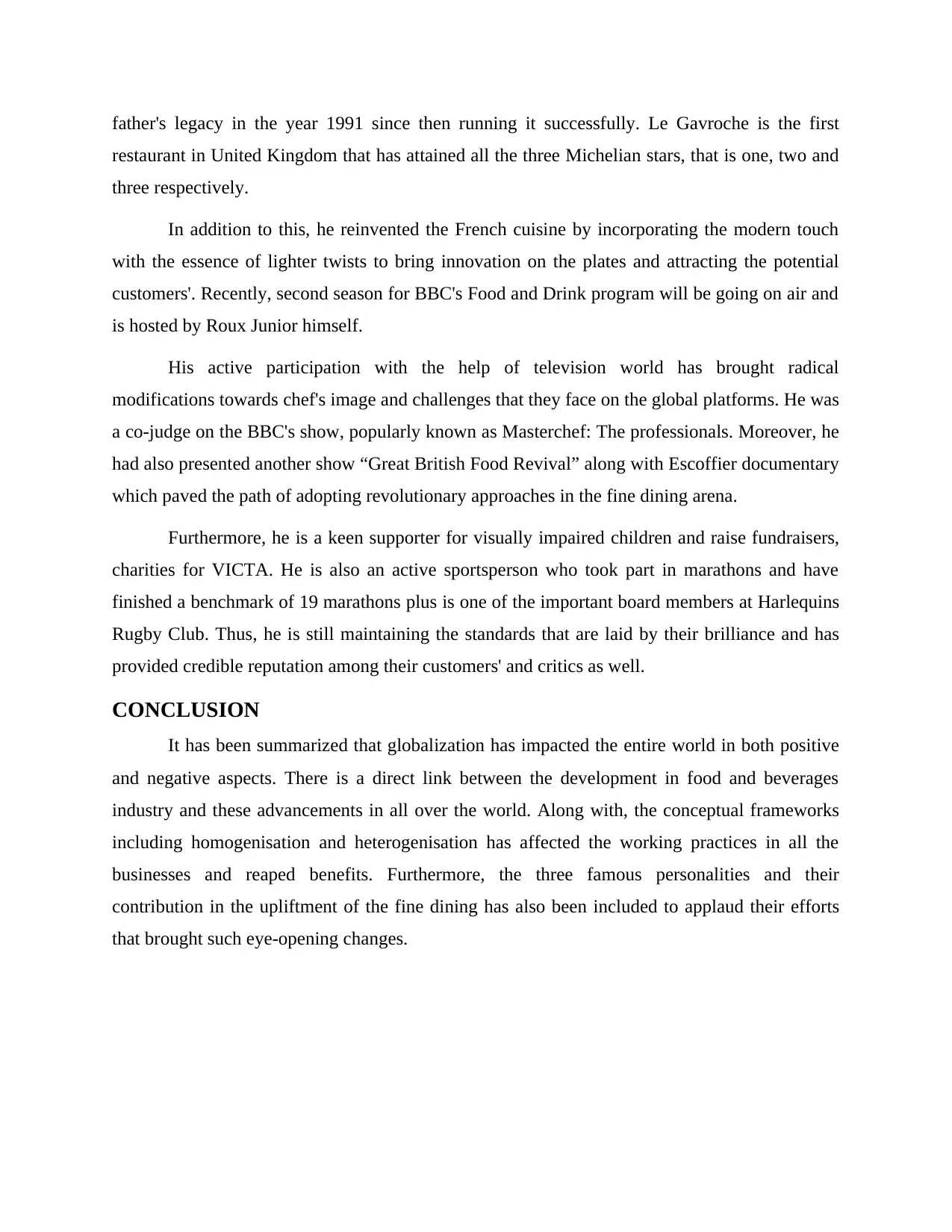
father's legacy in the year 1991 since then running it successfully. Le Gavroche is the first
restaurant in United Kingdom that has attained all the three Michelian stars, that is one, two and
three respectively.
In addition to this, he reinvented the French cuisine by incorporating the modern touch
with the essence of lighter twists to bring innovation on the plates and attracting the potential
customers'. Recently, second season for BBC's Food and Drink program will be going on air and
is hosted by Roux Junior himself.
His active participation with the help of television world has brought radical
modifications towards chef's image and challenges that they face on the global platforms. He was
a co-judge on the BBC's show, popularly known as Masterchef: The professionals. Moreover, he
had also presented another show “Great British Food Revival” along with Escoffier documentary
which paved the path of adopting revolutionary approaches in the fine dining arena.
Furthermore, he is a keen supporter for visually impaired children and raise fundraisers,
charities for VICTA. He is also an active sportsperson who took part in marathons and have
finished a benchmark of 19 marathons plus is one of the important board members at Harlequins
Rugby Club. Thus, he is still maintaining the standards that are laid by their brilliance and has
provided credible reputation among their customers' and critics as well.
CONCLUSION
It has been summarized that globalization has impacted the entire world in both positive
and negative aspects. There is a direct link between the development in food and beverages
industry and these advancements in all over the world. Along with, the conceptual frameworks
including homogenisation and heterogenisation has affected the working practices in all the
businesses and reaped benefits. Furthermore, the three famous personalities and their
contribution in the upliftment of the fine dining has also been included to applaud their efforts
that brought such eye-opening changes.
restaurant in United Kingdom that has attained all the three Michelian stars, that is one, two and
three respectively.
In addition to this, he reinvented the French cuisine by incorporating the modern touch
with the essence of lighter twists to bring innovation on the plates and attracting the potential
customers'. Recently, second season for BBC's Food and Drink program will be going on air and
is hosted by Roux Junior himself.
His active participation with the help of television world has brought radical
modifications towards chef's image and challenges that they face on the global platforms. He was
a co-judge on the BBC's show, popularly known as Masterchef: The professionals. Moreover, he
had also presented another show “Great British Food Revival” along with Escoffier documentary
which paved the path of adopting revolutionary approaches in the fine dining arena.
Furthermore, he is a keen supporter for visually impaired children and raise fundraisers,
charities for VICTA. He is also an active sportsperson who took part in marathons and have
finished a benchmark of 19 marathons plus is one of the important board members at Harlequins
Rugby Club. Thus, he is still maintaining the standards that are laid by their brilliance and has
provided credible reputation among their customers' and critics as well.
CONCLUSION
It has been summarized that globalization has impacted the entire world in both positive
and negative aspects. There is a direct link between the development in food and beverages
industry and these advancements in all over the world. Along with, the conceptual frameworks
including homogenisation and heterogenisation has affected the working practices in all the
businesses and reaped benefits. Furthermore, the three famous personalities and their
contribution in the upliftment of the fine dining has also been included to applaud their efforts
that brought such eye-opening changes.
⊘ This is a preview!⊘
Do you want full access?
Subscribe today to unlock all pages.

Trusted by 1+ million students worldwide
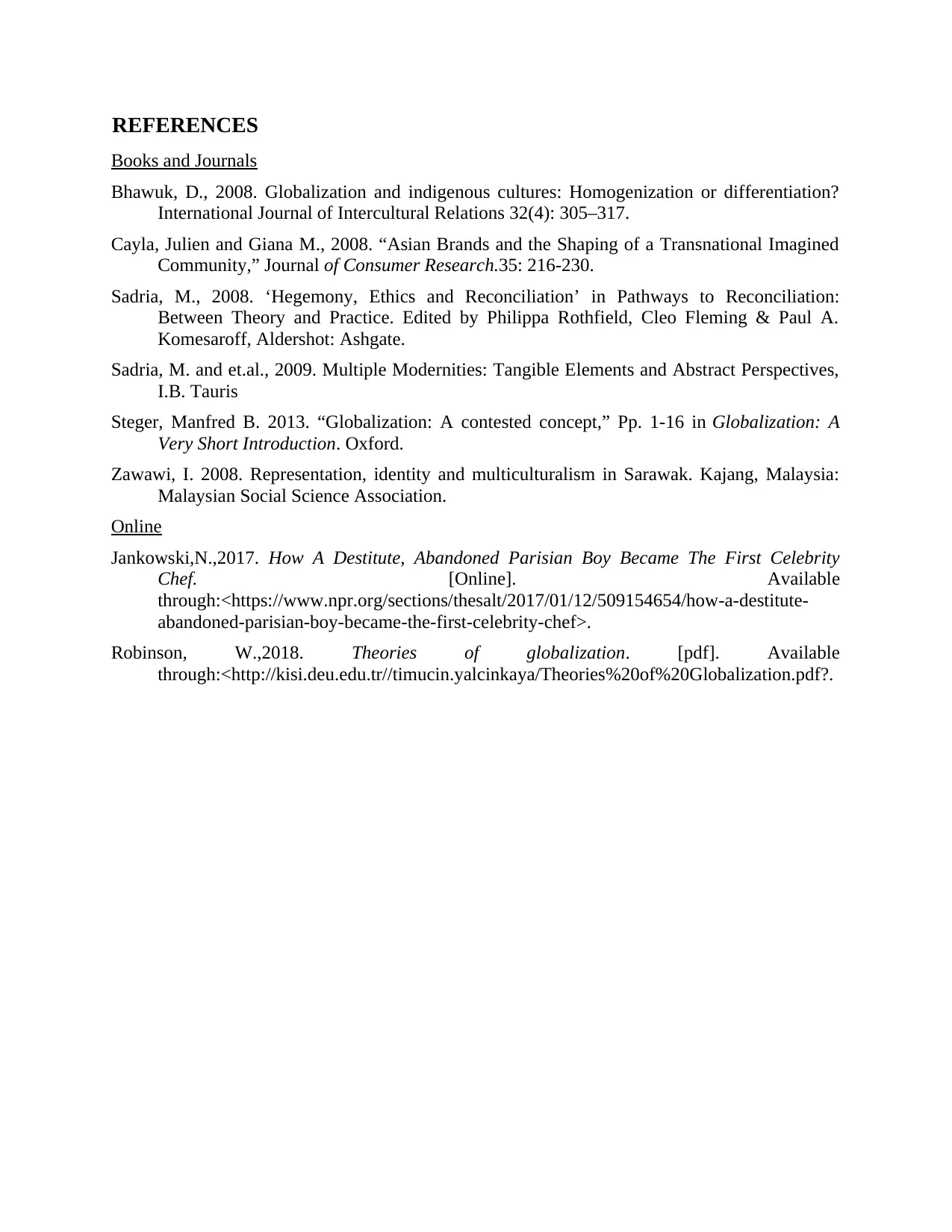
REFERENCES
Books and Journals
Bhawuk, D., 2008. Globalization and indigenous cultures: Homogenization or differentiation?
International Journal of Intercultural Relations 32(4): 305–317.
Cayla, Julien and Giana M., 2008. “Asian Brands and the Shaping of a Transnational Imagined
Community,” Journal of Consumer Research.35: 216‐230.
Sadria, M., 2008. ‘Hegemony, Ethics and Reconciliation’ in Pathways to Reconciliation:
Between Theory and Practice. Edited by Philippa Rothfield, Cleo Fleming & Paul A.
Komesaroff, Aldershot: Ashgate.
Sadria, M. and et.al., 2009. Multiple Modernities: Tangible Elements and Abstract Perspectives,
I.B. Tauris
Steger, Manfred B. 2013. “Globalization: A contested concept,” Pp. 1-16 in Globalization: A
Very Short Introduction. Oxford.
Zawawi, I. 2008. Representation, identity and multiculturalism in Sarawak. Kajang, Malaysia:
Malaysian Social Science Association.
Online
Jankowski,N.,2017. How A Destitute, Abandoned Parisian Boy Became The First Celebrity
Chef. [Online]. Available
through:<https://www.npr.org/sections/thesalt/2017/01/12/509154654/how-a-destitute-
abandoned-parisian-boy-became-the-first-celebrity-chef>.
Robinson, W.,2018. Theories of globalization. [pdf]. Available
through:<http://kisi.deu.edu.tr//timucin.yalcinkaya/Theories%20of%20Globalization.pdf?.
Books and Journals
Bhawuk, D., 2008. Globalization and indigenous cultures: Homogenization or differentiation?
International Journal of Intercultural Relations 32(4): 305–317.
Cayla, Julien and Giana M., 2008. “Asian Brands and the Shaping of a Transnational Imagined
Community,” Journal of Consumer Research.35: 216‐230.
Sadria, M., 2008. ‘Hegemony, Ethics and Reconciliation’ in Pathways to Reconciliation:
Between Theory and Practice. Edited by Philippa Rothfield, Cleo Fleming & Paul A.
Komesaroff, Aldershot: Ashgate.
Sadria, M. and et.al., 2009. Multiple Modernities: Tangible Elements and Abstract Perspectives,
I.B. Tauris
Steger, Manfred B. 2013. “Globalization: A contested concept,” Pp. 1-16 in Globalization: A
Very Short Introduction. Oxford.
Zawawi, I. 2008. Representation, identity and multiculturalism in Sarawak. Kajang, Malaysia:
Malaysian Social Science Association.
Online
Jankowski,N.,2017. How A Destitute, Abandoned Parisian Boy Became The First Celebrity
Chef. [Online]. Available
through:<https://www.npr.org/sections/thesalt/2017/01/12/509154654/how-a-destitute-
abandoned-parisian-boy-became-the-first-celebrity-chef>.
Robinson, W.,2018. Theories of globalization. [pdf]. Available
through:<http://kisi.deu.edu.tr//timucin.yalcinkaya/Theories%20of%20Globalization.pdf?.
1 out of 10
Related Documents
Your All-in-One AI-Powered Toolkit for Academic Success.
+13062052269
info@desklib.com
Available 24*7 on WhatsApp / Email
![[object Object]](/_next/static/media/star-bottom.7253800d.svg)
Unlock your academic potential
Copyright © 2020–2025 A2Z Services. All Rights Reserved. Developed and managed by ZUCOL.





